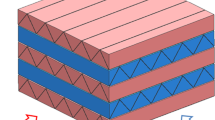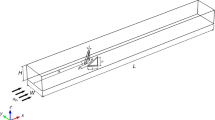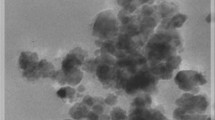Abstract
This experimental study investigates the effects of vortex-generator (VG) and Cu/water nanofluid flow on performance of plate-fin heat exchangers. The Cu/water nanofluids are produced by using a one-step method, namely electro-exploded wire technique, with four nanoparticles weight fractions (i.e. 0.1, 0.2, 0.3, and 0.4 %). Required properties of nanofluids are systematically measured, and empirical correlations are developed. A highly precise test loop is fabricated to obtain accurate results of the heat transfer and pressure drop characteristics. Experiments are conducted for nanofluids flow inside the plain and VG channels. Based on the experimental results, utilizing the VG channel instead of the plain channel enhances the heat transfer rate, remarkably. Also, the results show that the VG channel is more effective than the nanofluid on the performance of plate-fin heat exchangers. It is observed that the combination of the two heat transfer enhancement techniques has a noticeably high thermal–hydraulic performance, about 1.67. Finally, correlations are developed to predict Nusselt number and friction factor of nanofluids flow inside the VG channel.








Similar content being viewed by others
Abbreviations
- A c :
-
Minimum free flow area (m2)
- A ch.f :
-
Total surface area in contact with working fluid (m2)
- C p :
-
Specific heat (J kg−1 K−1)
- D h :
-
Hydraulic diameter (m)
- F h :
-
Channel height (m)
- F p :
-
Channel pitch (m)
- G :
-
Mass velocity (kg m−2 s−1)
- h :
-
Effective heat transfer coefficient (W m−2 K−1)
- L :
-
Channel length (m)
- M :
-
Number of the independent variables
- m :
-
Mass flow rate (kg s−1)
- Q conv :
-
Convective heat transfer rate (W)
- T :
-
Temperature (K)
- t :
-
Channel thickness (m)
- \( \dot{V} \) :
-
Volumetric flow rate (m3 s−1)
- V h :
-
Vortex height (m)
- V l :
-
Longitudinal vortex spacing (m)
- V t :
-
Transverse vortex spacing (m)
- ∆P :
-
Pressure drop (Pa)
- R :
-
Dependent variable
- R 2 :
-
Coefficient of determination
- ∆T :
-
Temperature difference (K)
- X :
-
Independent variables
- α :
-
Angle of attack (°)
- ρ :
-
Density (kg m−3)
- μ :
-
Dynamic viscosity (Pa s)
- κ :
-
Thermal conductivity (W m−1 K−1)
- φ :
-
Nanoparticle weight fraction
- j :
-
Colburn factor = Nu/RePr 1/3
- JF :
-
Thermal–hydraulic performance factor = (j VGC /j PC )/(f VGC /f PC )1/3
- f :
-
Fanning friction factor = ρD h ∆P/2LG 2
- Nu :
-
Nusselt number = hD h /κ
- Pr :
-
Prandtl number = μC p /κ
- Re :
-
Reynolds number = GD h /μ
- St :
-
Stanton number = h/GC p
- BF :
-
Base fluid
- NF :
-
Nanofluid
- PC :
-
Plain channel
- DW:
-
Deionized-water
- EEW:
-
Electro-exploded wire
- PEC:
-
Performance evaluation criteria
- PFHE:
-
Plate-fin heat exchangers
- PI:
-
Process intensification
- TEM:
-
Transmission electron microscope
- THW:
-
Transient hot-wire
- VG:
-
Vortex-generator
References
Stankiewicz A, Moulijn JA (2004) Re-engineering the chemical processing plant: process intensification. Marcel Dekker, New York
Bergles AE (1983) Augmentation of heat transfer, heat exchanger design handbook. Hemisphere Publishing Company, Washington
Brockmeier U, Guentermann Th, Fiebig M (1993) Performance evaluation of a vortex generator heat transfer surface and comparison with different high performance surfaces. Int J Heat Mass Transf 36(10):2575–2587
Khalil I, Heiba AA, Boehm R (2008) Comparison of plate fin compact heat exchanger performance. In: ASME international mechanical engineering congress and exposition
Biswas G, Chattopadhyay H (1992) Heat transfer in channel with built-in wing-type vortex generators. Int J Heat Mass Transf 35(4):803–8014
Zhu JX, Fiebig M, Mitra NK (1995) Numerical investigation of turbulent flows and heat transfer in a rib-roughened channel with longitudinal vortex generators. Int J Heat Mass Transf 38(3):495–501
Wang Q, Chen Q, Wang L, Zeng M, Huang Y, Xiao Z (2007) Experimental study of heat transfer enhancement in narrow rectangular channel with longitudinal vortex generators. Nucl Eng Des 237(7):686–693
Wu JM, Tao QW (2008) Numerical study on laminar convection heat transfer in a rectangular channel with longitudinal vortex generator, Part A: verification of field synergy principle. Int J Heat Mass Transf 51(5–6):1179–1191
Wu JM, Tao WQ (2008) Numerical study on laminar convection heat transfer in a channel with longitudinal vortex generator, Part B: parametric study of major influence factors. Int J Heat Mass Transf 51(13–14):3683–3692
Min C, Qi C, Kong X, Dong J (2010) Experimental study of rectangular channel with modified rectangular longitudinal vortex generators. Int J Heat Mass Transf 53(15–16):3023–3029
Habchi C, Russeil S, Bougeard D, Harion JL, Lemenand T, Valle DD, Peerhossaini H (2012) Enhancing heat transfer in vortex generator-type multifunctional heat exchangers. Appl Therm Eng 38:14–25
Gentry MC, Jacobi AM (1997) Heat transfer enhancement by delta-wing vortex generators on a flat plate: vortex interactions with the boundary layer. J Exp Therm Fluid Sci 14(3):231–242
Leu JS, Wu YH, Jang JY (2004) Heat transfer and fluid flow analysis in plate-fin and tube heat exchangers with a pair of block shape vortex generators. Int J Heat Mass Transf 47(19–20):4327–4338
Ferrouillat S, Tochon P, Garnier C, Peerhossaini H (2006) Intensification of heat transfer and mixing in multifunctional heat exchangers by artificially generated streamwise vorticity. Appl Therm Eng 26(16):1820–1829
Tian LT, He YL, Lei YG, Tao WQ (2009) Numerical study of fluid flow and heat transfer in a flat-plate channel with longitudinal vortex generators by applying field synergy principle analysis. Int Commun Heat Mass Transf 36(2):111–120
Zhou G, Ye Q (2012) Experimental investigations of thermal and flow characteristics of curved trapezoidal winglet type vortex generators. Appl Therm Eng 37:241–248
Wu JM, Tao WQ (2012) Effect of longitudinal vortex generator on heat transfer in rectangular channels. Appl Therm Eng 37:67–72
Chen Y, Fiebig M, Mitra NK (1998) Conjugate heat transfer of a finned oval tube with a punched longitudinal vortex generator in form of a delta winglet-parametric investigations of the winglet. Int J Heat Mass Transf 41(23):3961–3978
Chen Y, Fiebig M, Mitra NK (2000) Heat transfer enhancement of finned oval tubes with staggered punched longitudinal vortex generators. Int J Heat Mass Transf 43(3):417–735
Torii K, Kwak KM, Nishino K (2002) Heat transfer enhancement accompanying pressure-loss reduction with winglet-type vortex generators for fin-tube heat exchangers. Int J Heat Mass Transf 45(18):3795–3801
Kwak KM, Torii K, Nishino K (2003) Heat transfer and pressure loss penalty for the number of tube rows of staggered finned-tube bundles with a single transverse row of winglets. Int J Heat Mass Transf 46(1):175–180
Allison CB, Dally BB (2007) Effect of a delta-winglet vortex pair on the performance of a tube-fin heat exchanger. Int J Heat Mass Transf 50:5056–5072
Wu JM, Tao WQ (2007) Investigation on laminar convection heat transfer in fin-and-tube heat exchanger in aligned arrangement with longitudinal vortex generator from the viewpoint of field synergy principle. Appl Therm Eng 27(14–15):2609–2617
Chu P, He YL, Lei YG, Tian LT, Li R (2009) Three-dimensional numerical study on fin-and-oval-tube heat exchanger with longitudinal vortex generators. Appl Therm Eng 29(5–6):859–876
Zeng M, Tang LH, Lin M, Wang QW (2010) Optimization of heat exchangers with vortex-generator fin by taguchi method. Appl Therm Eng 30(13):1775–1783
Li J, Wang S, Chen J, Lei YG (2011) Numerical study on a slit fin-and-tube heat exchanger with longitudinal vortex generators. Int J Heat Mass Transf 54(9–10):1743–1751
Yang KS, Li SL, Chen IY, Chien KH, Hu R, Wang CC (2010) An experimental investigation of air cooling thermal module using various enhancements at low Reynolds number region. Int J Heat Mass Transf 53(25–26):5675–5681
Yang KS, Jhong JH, Lin YT, Chien KH, Wang CC (2010) On the heat transfer characteristics of heat sinks: with and without vortex generators. IEEE Trans Compon Packag Technol 33(2):391–397
Chomdee S, Kiatsiriroat T (2006) Enhancement of air cooling in staggered array of electronic modules by integrating delta winglet vortex generators. Int Commun Heat Mass Transf 33(5):618–626
Chomdee S, Kiatsiriroat T (2007) Air-cooling enhancement with delta winglet vortex generators in entrance region of in-line array electronic modules. J Heat Transf Eng 28(4):372–379
Ma J, Huang YP, Huang J, Wang YL, Wang QW (2010) Experimental investigations on single-phase heat transfer enhancement with longitudinal vortices in narrow rectangular channel. Nucl Eng Des 240(1):92–102
Liu C, Teng JT, Chu JC, Chiu YL, Huang S, Jin S, Dang T, Greif R, Pan HH (2011) Experimental investigation on liquid flow and heat transfer in rectangular microchannel with longitudinal vortex generators. Int J Heat Mass Transf 54(13–14):3069–3080
Ahmed HE, Mohammed HA, Yusoff MZ (2012) An overview on heat transfer augmentation using vortex generators and nanofluids: approaches and applications. Renew Sustain Energy Rev 16:5951–5993
Ahmed HE, Mohammed HA, Yusoff MZ (2012) Heat transfer enhancement of laminar nanofluids flow in a triangular duct using vortex generator. Superlattices Microstruct 52:398–415
Murshed SMS, Leong KC, Yang C (2008) Thermophysical and electrokinetic properties of nanofluids—a critical review. Appl Therm Eng 28(17–18):2109–2125
Liu MS, Lin MCC, Tsai CY, Wang CC (2006) Enhancement of thermal conductivity with Cu for nanofluids using chemical reduction method. Int J Heat Mass Transf 49(17–18):3028–3033
Wang CC, Lo J, Lin YT, Liu MS (2002) Flow visualization of wave-type vortex generators having inline fin-tube arrangement. Int J Heat Mass Transf 45(9):1933–1944
Kline SJ, McClintock FA (1953) Describing uncertainties in single-sample experiments. Mech Eng 75:3–8
Yun JY, Lee KS (2000) Influence of design parameters on the heat transfer and flow friction characteristics of the heat transfer with slit fins. Int J Heat Mass Transf 43(14):2529–2539
Acknowledgments
The author would like to express their thanks to University of Semnan and Materials and Energy Research Center for their financial supports through the set-up fabrication and research implementation.
Author information
Authors and Affiliations
Corresponding author
Rights and permissions
About this article
Cite this article
Khoshvaght-Aliabadi, M. Thermal performance of plate-fin heat exchanger using passive techniques: vortex-generator and nanofluid. Heat Mass Transfer 52, 819–828 (2016). https://doi.org/10.1007/s00231-015-1603-6
Received:
Accepted:
Published:
Issue Date:
DOI: https://doi.org/10.1007/s00231-015-1603-6




